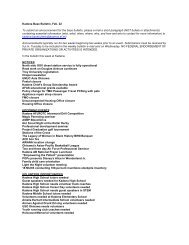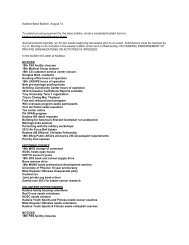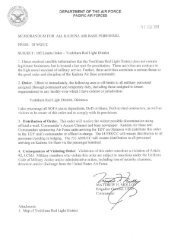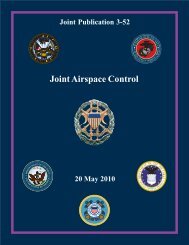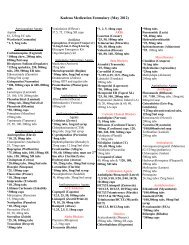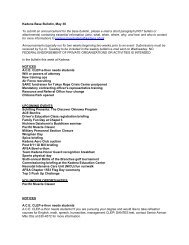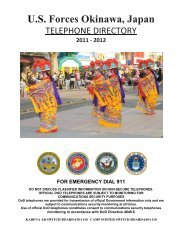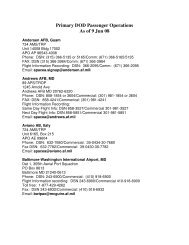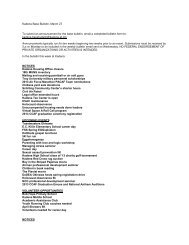here - Kadena Air Base
here - Kadena Air Base
here - Kadena Air Base
You also want an ePaper? Increase the reach of your titles
YUMPU automatically turns print PDFs into web optimized ePapers that Google loves.
Consumer Confidence Report (CCR)<br />
2007 Water Quality Report<br />
<strong>Kadena</strong> <strong>Air</strong> <strong>Base</strong>, Japan<br />
Introduction<br />
This is an annual report on the quality of tap water delivered to <strong>Kadena</strong><br />
<strong>Air</strong> <strong>Base</strong>. This report’s sole purpose is to increase consumer knowledge<br />
of drinking water quality, sources, susceptibility, treatment, and drinking<br />
water supply management. It also increases awareness of consumers to<br />
potential health risks, so they may make informed decisions to reduce<br />
those risks, including taking steps toward protecting their water supply.<br />
What is a Consumer Confidence Report<br />
In 1996, Congress amended the Safe Drinking Water Act. It added a<br />
provision requiring that all community water systems deliver to their<br />
customers a brief annual water quality report. The Japan Environmental<br />
Governing Standard (JEGS) does not have a requirement for generation<br />
of a CCR. However, <strong>Air</strong> Force Instruction 48-144, Safe Drinking Water<br />
Surveillance Program, provides guidance for overseas installations in<br />
preparing a water quality report that may be modeled after a CCR.<br />
Is my water safe<br />
Absolutely! No one is concerned more about the potability of your water<br />
than 18 CES/Utilities and Bioenvironmental Engineering personnel. Last<br />
year, we conducted tests for over 100 contaminants. Of these 100<br />
contaminates, we only detected 10 contaminates and found only 1 at a<br />
level higher than the JEGS Maximum Contaminant Level (MCL). As we<br />
told you at the time, our water temporarily exceeded drinking water<br />
standards. Our water system exceeded a maximum contaminant level for<br />
total coliform. The maximum contaminant level for total coliform is<br />
more than one positive routine sample per month or a positive repeat<br />
sample.. Coliforms are bacteria that are naturally present in the<br />
environment and are used as an indicator that other, potentially-harmful,<br />
bacteria may be present. Coliforms were found in more samples than<br />
allowed and this was a warning of potential problems. Whenever we<br />
detect coliform bacteria in any sample, we perform follow-up testing<br />
until all samples are negative. We immediately notify 18 CES/Utilities<br />
flight who flushes the main lines to remove any potential harmful<br />
bacteria.<br />
Do I need to take special precautions<br />
Some people may be more vulnerable to contaminants in drinking water<br />
than the general population. Immuno-compromised persons such as<br />
persons with cancer undergoing chemotherapy, persons who have<br />
undergone organ transplants, people with HIV/AIDS or other immune<br />
system disorders, some elderly, and infants can be particularly at risk<br />
from contaminants. These people should seek advice about drinking<br />
water from their health care providers. EPA/Centers for Disease<br />
Control (CDC) guidelines on appropriate means to lessen the risk of<br />
infection by Cryptosporidium and other microbial contaminants are<br />
available from the Safe Water Drinking Water Hotline (800-426-4791).<br />
Why are t<strong>here</strong> contaminants in my drinking water<br />
Drinking water, including bottled water, may reasonably be expected to<br />
contain small amounts of some contaminants. The presence of<br />
contaminants does not necessarily indicate that water poses a health risk.<br />
As water travels over the surface of the land or through the ground, it<br />
dissolves naturally occurring minerals and, in some cases, radioactive<br />
material, and can pick up substances resulting from the presence of<br />
animals or from human activity. Microbial contaminants, such as viruses<br />
and bacteria, may come from sewage treatment plants, septic systems,<br />
agricultural livestock operations, and wildlife. Inorganic contaminants,<br />
such as salts and metals, can be naturally-occurring or result from urban<br />
stormwater runoff, industrial, or domestic wastewater discharges, oil and<br />
gas production, mining, or farming. Pesticides and herbicides may come<br />
from a variety of sources such as agriculture, urban stormwater runoff,<br />
and residential uses. Organic chemical contaminants, including synthetic<br />
and volatile organic chemicals, are by-products of industrial processes<br />
and petroleum production, and can also come from gas stations, urban<br />
stormwater runoff, and septic systems. Radioactive contaminants can be<br />
naturally occurring or be the result of oil and gas production and mining<br />
activities. In order to ensure that tap water is safe to drink, EPA<br />
prescribes regulations that limit the amount of certain contaminants in<br />
water provided by public water systems. Food and Drug Administration<br />
(FDA) regulations establish limits for contaminants in bottled water,<br />
which must provide the same protection for public health. In Japan, the<br />
Government of Japan and the US Forces, Japan, also regulate the quality<br />
of drinking water.<br />
<strong>Kadena</strong> <strong>Air</strong> <strong>Base</strong> Water System Information<br />
<strong>Kadena</strong> AB water is operated and maintained by the 18th Civil<br />
Engineering Squadron. The water is pumped from the Ishikawa and<br />
Chatan water treatment plants. The water supply to these treatment<br />
plants is a combination of surface rivers and reservoirs, a desalination<br />
plant fed by the East China Sea, and ground water wells located on<br />
<strong>Kadena</strong> AB.<br />
Monitoring of Your Drinking Water<br />
We use only EPA-approved laboratory methods to analyze your drinking<br />
water. Our trained personnel take water samples from the distribution<br />
system and residents’ taps. Samples are then shipped to an accredited<br />
laboratory w<strong>here</strong> a full spectrum of water quality analyses is performed.<br />
The 18th Aerospace Medicine Squadron, Bioenvironmental Engineering<br />
Flight, collected 1500 samples in 2007, which were analyzed for roughly<br />
100 different contaminants. Results are located on the next page.<br />
THIS REPORT IS AVAILABLE ON THE WEB:<br />
http://www.kadena.af.mil<br />
For More Information Contact:<br />
18 AMDS/SGPB<br />
18amds.sgpb@kadena.af.mil<br />
Bioenvironmental Engineering Flight<br />
DSN: 315-634-4752
Inorganic<br />
Contaminants<br />
Unit of<br />
Measurement<br />
2007 Water Quality Table<br />
MCL<br />
Highest Level<br />
Detected<br />
Violation<br />
Barium mg/L 2 0.0072 No<br />
Sodium mg/L 200 33 No<br />
Possible sources of contamination<br />
Discharges of drilling wastes; discharge from metal<br />
refineries; erosion of natural deposits<br />
Seawater from storm spray, underground intrusion or<br />
relic salt-water pockets<br />
Lead mg/L AL = 0.01 0.012 No Corrosion from household plumbing systems<br />
1 out of 30 samples were found to have lead levels in excess of the Action Level of 0.01 mg/L. The JEGS states 90% of samples must be below the action<br />
level.<br />
Copper mg/L AL = 1.3 0.276 No Erosion of natural deposits<br />
Zero out of 30 samples were found to have copper levels in excess of the Action Level of 1.3 mg/L. The JEGS states 90% of samples must be below the<br />
action level.<br />
Total Nitrate/Nitrites<br />
(measured as Nitrogen)<br />
mg/L 10 1.1 No<br />
Runoff from fertilizer use; leaching from septic<br />
tanks, sewage; erosion of natural deposits.<br />
Asbestos (CY2006) MFL 7 1.66 No<br />
Decay of asbestos cement water mains; erosion of<br />
natural deposits<br />
Microbiological<br />
Unit of<br />
Highest Level<br />
MCL<br />
Contaminants<br />
Measurement<br />
Detected<br />
Violation<br />
Possible sources of contamination<br />
Total Coliform<br />
# of Positives /<br />
month<br />
> 1 positive 4 Yes Naturally present in the environment<br />
MCL was exceeded on one occasion in 2007, one routine sample and all 3 re-samples were positive (detected) in December.<br />
Residual Disinfectants<br />
Unit of<br />
Highest Level<br />
MCL<br />
Measurement<br />
Detected<br />
Violation<br />
Possible sources of contamination<br />
Free Chlorine PPM NA 1.0 No Water additive used to control microbes<br />
Radioactive<br />
Unit of<br />
Highest Level<br />
MCL<br />
Contaminants<br />
Measurement<br />
Detected<br />
Violation<br />
Possible sources of contamination<br />
Gross Alpha (CY2006) pCi/L 15 2 No Erosion of natural deposits<br />
Volatile Organic<br />
Unit of<br />
Highest Level<br />
MCL<br />
Chemicals<br />
Measurement<br />
Detected<br />
Violation<br />
Possible sources of contamination<br />
Total Trihalomethanes mg/L 0.1 0.0553 No By-product of drinking water chlorination<br />
Dichloromethane mg/L 0.005 0.0008 No<br />
Discharge from pharmaceutical and chemical<br />
factories<br />
Toluene mg/L 1 0.0010 No<br />
By spills on land during the storage, transport and<br />
disposal of fuels and oils<br />
Synthetic Volatile<br />
Organic Chemicals<br />
Unit of<br />
Measurement<br />
MCL<br />
Highest Level<br />
Detected<br />
Violation<br />
Dioxin mg/L 0.00000003 0.000000005 No<br />
Possible sources of contamination<br />
Emissions from waste incineration and other<br />
combustion; Discharge from chemical factories<br />
Chlordane (CY2006) mg/L 0.002 0.001 No Residue of banned termiticide<br />
Unit of<br />
Highest Level<br />
Perchlorate<br />
MCL<br />
Violation<br />
Possible sources of contamination<br />
Measurement<br />
Detected<br />
Perchlorate (CY2006) µg/L 24 4 No<br />
Abbreviations Used:<br />
NA: not applicable<br />
mg/L: milligrams per liter<br />
µg/L: micrograms per liter<br />
ppm: parts per million<br />
MFL: millions of fibers per liter<br />
pCi/L: picrocuries per liter<br />
CY: Calendar Year<br />
Salts derived from natural deposits and<br />
manufacturing<br />
Definitions Used:<br />
MCL: Maximum Contaminant Level: The highest level of a contaminant that is allowed in drinking water.<br />
AL – Action Level: The concentration of a contaminant which, if exceeded, triggers treatment or other requirements which a water system must follow.
______________________________________________________________________________________________<br />
Frequently Asked Questions<br />
Why does the water sometimes look rusty<br />
Rusty or reddish tinted water may occur because of a sudden change in<br />
pressure due to improper flushing of a fire hydrant, etc. Iron causes the<br />
discoloration: it is not a health risk. The normal flow of water will<br />
usually clear the mains within two hours or less. Check you water by<br />
flushing a commode bowl three times every 15 to 20 minutes. If you live<br />
on or near the end of a long, main distribution line, additional flushing<br />
may be required. Galvanized iron pipes or fittings within a home or<br />
building may also cause discolored water. Running the water will clear<br />
the piping system. If the hot water is rusty, the water heater may need to<br />
be flushed.<br />
What is a Precautionary Boil Advisory<br />
If a problem is detected in the system, such as a drop in pressure, a water<br />
main break, or a routine positive coliform sample, Bioenvironmental<br />
Engineering puts out a Precautionary Boil Advisory and immediate<br />
testing requirements go into effect. Boil Advisories are precautionary<br />
and do NOT necessarily mean that contamination has been detected. The<br />
notice will describe any precautions you need to take such as boiling your<br />
water to kill any potential bacteria. Retesting continues until the system<br />
can reliably demonstrate that it is free of problems.<br />
Is it okay to drink from a garden hose<br />
The water is safe but a garden hose is treated with special chemicals that<br />
make it flexible. Those chemicals are not good for you and nether are the<br />
bacteria that may be growing inside the hose.<br />
Will using a home water filter make the water safer or<br />
healthier<br />
Most filters improve the taste, smell and appearance of water, but they<br />
don’t necessarily make the water safer or healthier. Please keep in mind<br />
that filters require regular maintenance and replacement, if ignored, water<br />
quality problems may occur.<br />
What can I do to improve the quality of my drinking water<br />
Running the cold water tap for 30 seconds prior to use helps to flush out<br />
metals that may leach into the water that has been sitting in the pipes<br />
overnight. Water used for consumption should always come from the<br />
cold water tap. Hot water has more potential to leach metals into the<br />
water.<br />
How will I know if my water isn't safe to drink<br />
Your water supplier must notify you by newspaper, mail, radio, TV, or<br />
hand-delivery a notice if your water doesn't meet standards or if t<strong>here</strong> is a<br />
waterborne disease emergency. The notice will describe any precautions<br />
you need to take, such as boiling your water.<br />
Doesn’t the <strong>Kadena</strong> water system have a lead problem<br />
In 2007, 1 out of 30 samples were found to have lead levels in excess of<br />
the Action Level of 0.01 mg/L. The Japan Environmental Governing<br />
Standards (JEGS) states 90% of samples must be below the action level.<br />
The water system met this criteria in February and August 2006 and<br />
reduced monitoring took effect in 2007.<br />
I don’t like the taste/smell/appearance of my tap water What’s<br />
wrong with it<br />
Even when water meets standards, you may still object to its taste, smell,<br />
or appearance. Taste, smell and appearance are also known as aesthetic<br />
characteristics and do not pose health effects. Common complaints about<br />
water aesthetics include: temporary cloudiness (typically caused by air<br />
bubbles) or chlorine taste (which can be improved by letting the water<br />
stand exposed to the air).<br />
What is backflow and how can I prevent it<br />
It’s just what it sounds like: the water is flowing in the opposite direction<br />
from its normal flow. With the direction of the flow reversed, due to a<br />
change in pressure, backflow can allow contaminants to be pulled into<br />
the drinking water. The following tips may help to reduce the potential<br />
for backflow:<br />
- Don’t submerge hoses in buckets, pools, tubs, or sinks.<br />
- Don’t attach chemical sprayers to your garden hose without first<br />
installing a backflow prevention device such as a vacuum breaker on<br />
the spigot. This is an inexpensive device that can be purchased at any<br />
plumbing or hardware store and installation is as easy as attaching your<br />
garden hose to a spigot. The chemicals sued on your lawn can be fatal<br />
if ingested.



